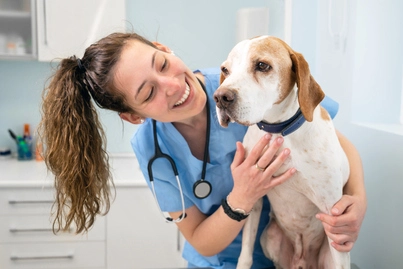How often do you take a peek inside your dog’s mouth?
Many pet owners only get a good look in their dog’s mouth when they have to pry some unacceptable food from the gaping maw.
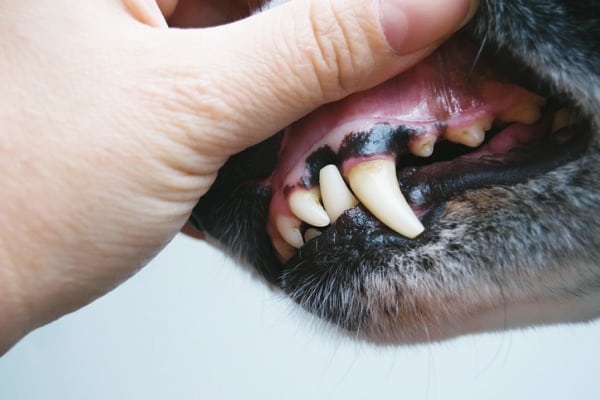
And we get it.
That mouth of teeth isn’t something many of us want to get our fingers near, even with the gentlest dogs.
But did you know that the inside of your dog’s mouth and their gums are something every pet owner should familiarize themselves with?
If, by chance, you noticed that your dog’s gums seem to be turning black, you might be concerned or alarmed.
This is why getting to know your dog’s mouth early on is essential – black spots or coloring might be perfectly normal.
Contact a Vet
Alternatively, you can have a quick chat with a vet online now, which is both a cost and time savings.
Connect with a verified veterinarian in minutes. No waiting for appointments or office hours. No high fees. Your pet's health made convenient and worry-free.
Additionally, we cover some key points below on how to tell if black spots or black gums are cause for concern or just something to be expected.
There are a few things to look out for and other cases when you can relax about those black spots.
When Are Black Spots and Black Gums Normal?
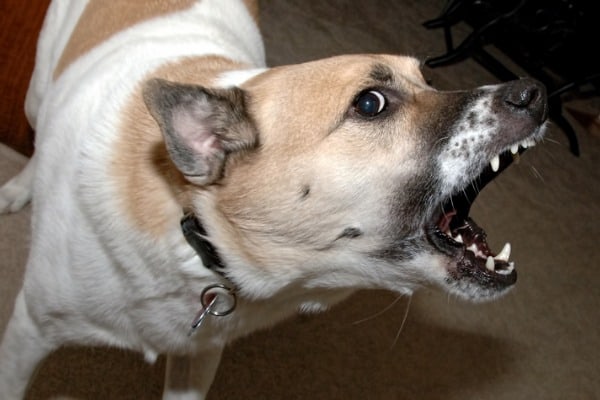
Dark pigmentation inside the mouth can be down to your dog’s DNA. Some breeds have entirely dark mouths, and others have black spots or patches.
If you look in your dog’s mouth and think, “my dog’s gums are black,” you can relax if they’re a particular breed.
If you own a Chow, Shar-Pei, or a mix of either breed, the entire inside of their mouths is likely a dark, bluish color.
Why do these breeds tend to have this unique coloring in their mouths? No one really knows exactly why, but it’s completely normal.
So if your dog has any Chow or Shar-Pei in their blood, don’t worry about their mouths and tongues being a blue-black hue.
Some other breeds are predisposed to having spots on the tongue, roof, insides of the chops, and gum area.
Dog breeds with black gums include Pomeranians, some retriever breeds, Mastiffs, Newfoundlands, bully breeds, Irish Setters, Australian and German Shepherds.
A myth you heard?
Maybe you heard that dogs with this coloring are supposedly more aggressive. It’s a rumor that has no basis in science and no evidence to back it up.
So if your dog has black spots in their mouth, don’t worry – it has no bearing on their temperament any more than if your dog has pale gums.
More fake news:
There’s also a wise old tale that they’re smarter and easier to train.
While it’s a bit of a kinder rumor, it has never been proven.
The only thing for sure about natural pigmentation in your dog’s mouth is that it’s in their genes.
When Should You Be Concerned?

If you aren’t sure about black spots or gums on your dog, a vet can tell you if it’s normal or not.
Then, you can monitor your dog’s mouth for any changes that could be an indication of something serious.
So if your dog has some new spots or blackening of gums, what could it be?
Connect with a verified veterinarian in minutes. No waiting for appointments or office hours. No high fees. Your pet's health made convenient and worry-free.
It’s a Matter of Age
Elderly dogs can develop these spots and even show up in middle age.
It’s usually just a part of an aging dog, but the texture and size can be a red flag for something else.
A Sign of Cancer
Dogs can develop melanoma in the mouth; a big warning sign is if a black spot is raised.
Any dog can be affected, but it’s more common in males and specific breeds.
Chows, Golden Retrievers, and Spaniels can be at a higher risk for this condition.
It’s important to note that a cancerous spot might not present itself as black – it could be a pink, gray, or blue color. Regardless of the color, if it’s raised, get to the vet ASAP.
Other signs to look out for include awful breath or bleeding of the gums.
These types of cancers can metastasize rapidly, so early diagnosis and treatment is the best weapon against them.
They’re Not Getting Enough Oxygen
Gums that gradually darken over time can be an indicator that your dog has an oxygenation disorder.
A broad range of things can cause such a disorder in dogs.
It could be a malformation of the respiratory system, a respiratory infection, or exposure to fungi or parasites.
While these things usually don’t put your dog in immediate danger, they can cause symptoms that will cause your dog’s health to deteriorate over time.
One of the tell-tale signs that your dog is suffering from an oxygenation disorder is gums that seemingly grow darker for no apparent reason.
A dog’s gums turning black, especially a younger dog, is something to take seriously.
Since the underlying causes are essential to treat sooner rather than later, a vet’s diagnosis is the first step to take if you’ve noticed changes in your dog’s gums.
Some things that cause these issues are out of your control, but there are ways you can protect your dog’s respiratory health.
Don’t expose them to cigarette smoke, and make sure there aren’t any harmful molds or fungi in the dog’s environment.
The good news is that these measures will also protect your health – it’s a win-win.
Cyanosis
If your dog’s gum changes come on rapidly, they could be in respiratory distress and need to see a vet immediately.
They could be suffering from cyanosis, meaning there is a severe lack of oxygen in your dog’s blood.
This is considered a medical emergency, and the root issue needs to be addressed immediately.
Causes include pneumonia, congestive heart failure, shock, and some poisons.
The prognosis depends on the reason behind the decrease in oxygen in the blood, so treatments and options may vary.
This is why it’s vital to seek a diagnosis as soon as you notice the symptoms.
Gingivitis
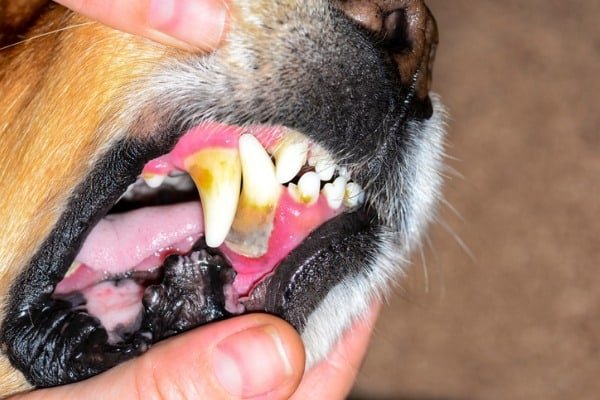
Some dog parents slack in dental health for their pets.
If you notice a thin line of black where their teeth meet their gums, it could be a sign of gum disease.
In short, bacteria have claimed this area of your dog’s mouth and have been given the perfect environment in which to multiply.
Early signs of gingivitis besides the darkening of the gum line include foul breath and yellowing teeth.
But left untreated, the bacteria can invade further and compromise the roots of your dog’s teeth. Tooth loss can occur in severe cases.
It gets worse:
If losing teeth isn’t bad enough, the inflamed gums can become very painful for your dog.
They might refuse food, causing a whole new set of health issues.
If your dog already has signs of gingivitis, they’ll need a professional cleaning at the vet’s office to get back on track with their oral health.
From there, regular brushing at home and periodic cleanings administered by the vet can keep their mouths in good shape.
What about diet?
Diet can also be to blame when it comes to gingivitis. Junk food and too many human treats can contribute to this condition and many others.
Dog food with a poor nutrient balance and too many starchy fillers can also cause dental issues for your dog.
There are some indications that dogs with severe, recurring gingivitis can benefit from a raw food diet.
But you should discuss this option with your dog’s vet before making any drastic dietary changes.
Keeping Track of Your Dog’s Mouth
Many of us have an inherent drive to stay away from our dog’s mouths.
Even the sweetest of pets can accidentally bite fingers if you’re trying to poke a pill down their throat or take something away from them that they shouldn’t be eating.
But establishing a relationship based on trust is important for your dog’s oral health – and so is getting comfortable with your dog’s mouth.
Brush Up on Doggie Dentistry
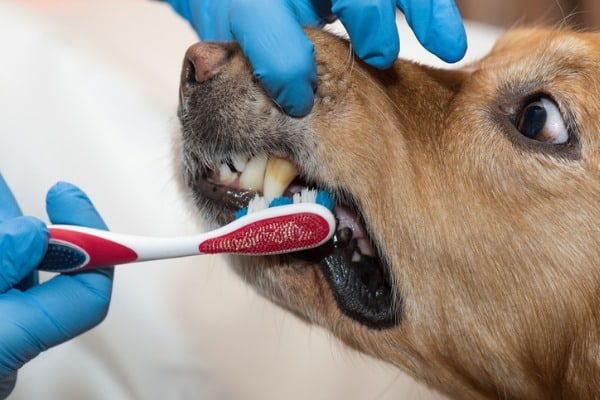
Brushing their teeth is the best opportunity to check in on any changes in your dog’s mouth.
Some vets recommend daily brushing. But at the very least, their teeth need brushing several times a week.
Either way, you can care for your dog’s teeth and multitask by keeping an eye out for abnormalities.
What You’ll Need
Dental supplies for humans won’t do the trick. The flavors in toothpaste can be enough to make your dog hate the ritual from the start.
There are special toothbrushes for dogs. Some are designed to fit over your finger, while others resemble the one sitting on your bathroom sink.
Why do you need a particular toothpaste for your dog?
Strong toothpaste can cause a burning sensation in their mouths that will put you and the toothbrush on their bad list right away.
Plus, some of the cleaning agents in our toothpaste would harm a dog if they were ingested.
They can’t exactly be taught to swish and spit as we do.
A huge no-no is using any toothpaste containing xylitol, which can be fatal in some cases.
Dog toothpaste is safe to swallow and flavored to be more enticing for your pup.
We recommend this Veterinary Strength Enzymatic Poultry Flavor Dog Toothpaste
Brushing the Pearly Fangs
If you’ve just adopted a dog or a puppy, start teaching them early on that regular brushing is a fact of life.
They might resist at first, but you can use positive reinforcement.
And yes, you can “bribe” them with rewards so they associate brushing time with a tasty snack or their favorite toy.
Some dogs are good sports about having their teeth brushed. Others can turn into little furry monsters the moment they see the toothbrush.
If your dog is difficult when it’s time to brush, you’ll need to acclimate them to the process slowly.
It’ll save stress, nipped fingers, and broken trust if you let them adjust over time rather than forcing it upon them.
Here’s how:
Start by getting your dog used to having your hands around their mouths.
Gently pet the outsides of their mouths, and work your way to massaging their gums.
We’re giving you the go-ahead to stick your fingers in your dog’s mouth.
Massaging your dog’s gums is an easy way to help them get used to an object in their mouth.
Start doing it in ten-second increments and increase it to about a minute.
Remember to reward often – each positive response to this process warrants positive reinforcement.
A coveted toy or treat on hand is perfect for teaching them some positive association with teeth brushing.
Once they’re comfortable with you massaging their gums, you can add toothpaste to the equation. Put it on your finger, and let them sniff it.
You should reward them as soon as they decide to taste it on their own.
Massage their gums with toothpaste a few times to let them get used to the taste.
Finally, you can introduce the toothbrush. Again, apply the paste and let them sniff and taste it before brushing.
You can slowly decrease the time between showing them the brush and giving them their reward until the reward comes after brushing is done.
It might sound counterintuitive to feed them a treat right after brushing their teeth, but it won’t negate the brushing unless it’s something sugary.
A Note for Special Cases
This ritual is no big deal for some people, but dogs with behavioral issues can cause some speed bumps in the process.
Luckily, dogs are great about letting you know they’ve had enough if they growl or show their teeth when being pet, back off and give them a break.
The vast majority of dogs aren’t going to be aggressive with their owners when it comes to teeth brushing.
Dogs with more severe aggression problems might need cleanings done at the vet’s under sedation – and some behavioral training with a professional trainer.
Don’t Forget to Inspect Their Mouth
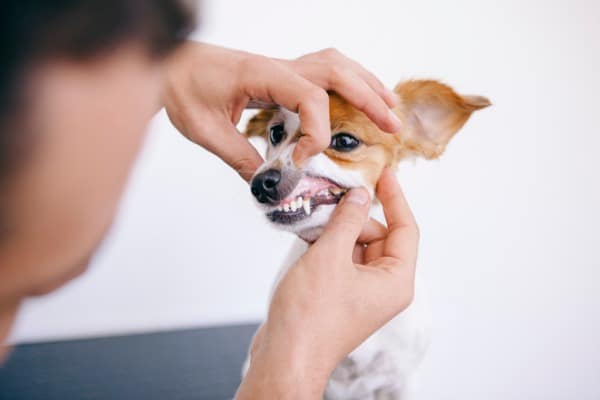
A considerable benefit of brushing your dog’s teeth is it provides a perfect opportunity to look for unusual spots or coloring.
Regular brushing means you’ll become very familiar with what your dog’s mouth looks like, and you’ll notice quickly if anything changes.
Make Their Mouths Your Business
Good oral health in your dog sets the stage for overall health.
Keeping an eye on their mouths is one of the best habits you can form for them.
Don’t wait until you see your dog scratching at their mouth, for example, to let you know there may be a problem.
There are some conditions and symptoms to look out for, and some cases when the vet needs to have a look inside your dog’s mouth.
But black spots on a dog’s gums are often out of your control and have no cause for panic.
Their breed will determine if they naturally come by these spots or black gums on dogs.
The biggest takeaway here? Regular brushing is the best way to make sure you’ll notice anything unusual on their gums.

